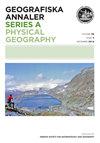Uncertainties on the GIS based potential natural vegetation simulation using Comprehensive and Sequential Classification System
IF 1.8
4区 地球科学
Q3 GEOGRAPHY, PHYSICAL
Geografiska Annaler Series A-Physical Geography
Pub Date : 2020-10-19
DOI:10.1080/04353676.2020.1832753
引用次数: 1
Abstract
ABSTRACT The use of GIS-based ecological models is increasing and the accuracy of input datasets of these models is improving. Still, there is a significant gap in quantifying the uncertainty related to the input data and the accuracy of these models’outputs. This study quantified error in annual cumulative temperature derived from using daily mean temperature and monthly mean temperature, and the uncertainty and error propagated in the Comprehensive and Sequential Classification System (CSCS) model that predicts Potential Natural Vegetation (PNV) in China. The error in annual cumulative temperature derived from daily mean temperature and monthly mean temperature is particularly high in Northwest and Northern China. The deviations in annual cumulative temperature have different effects on each PNV including edge effects on the model’s predictability due to error propagation in the interpolation method and overlay analysis. Future research can focus on the assessment of model behavior with the uncertainty of data itself and different spatial analysis methods including the spatial resolution of datasets. There is a need to develop a unique algorithm that would enable a better assessment of attribute error and location error in the spatial modeling.基于GIS的综合序列分类系统潜在自然植被模拟的不确定性
基于gis的生态模型的使用越来越多,这些模型的输入数据集的准确性也在不断提高。尽管如此,在量化与输入数据和这些模型输出的准确性相关的不确定性方面仍存在重大差距。本文对中国潜在自然植被(PNV)综合序列分类系统(CSCS)预测模型的年累积气温误差进行了量化,并分析了模型的不确定性和传播误差。由日平均气温和月平均气温推导出的年积温误差在西北和华北地区特别大。年积温的偏差对各PNV有不同的影响,包括插值方法和叠加分析中的误差传播对模式可预测性的边缘效应。未来的研究可侧重于利用数据本身的不确定性和不同的空间分析方法(包括数据集的空间分辨率)来评估模型行为。有必要开发一种独特的算法,以便更好地评估空间建模中的属性误差和位置误差。
本文章由计算机程序翻译,如有差异,请以英文原文为准。
求助全文
约1分钟内获得全文
求助全文
来源期刊
CiteScore
3.60
自引率
0.00%
发文量
12
审稿时长
>12 weeks
期刊介绍:
Geografiska Annaler: Series A, Physical Geography publishes original research in the field of Physical Geography with special emphasis on cold regions/high latitude, high altitude processes, landforms and environmental change, past, present and future.
The journal primarily promotes dissemination of regular research by publishing research-based articles. The journal also publishes thematic issues where collections of articles around a specific themes are gathered. Such themes are determined by the Editors upon request. Finally the journal wishes to promote knowledge and understanding of topics in Physical Geography, their origin, development and current standing through invited review articles.

 求助内容:
求助内容: 应助结果提醒方式:
应助结果提醒方式:


